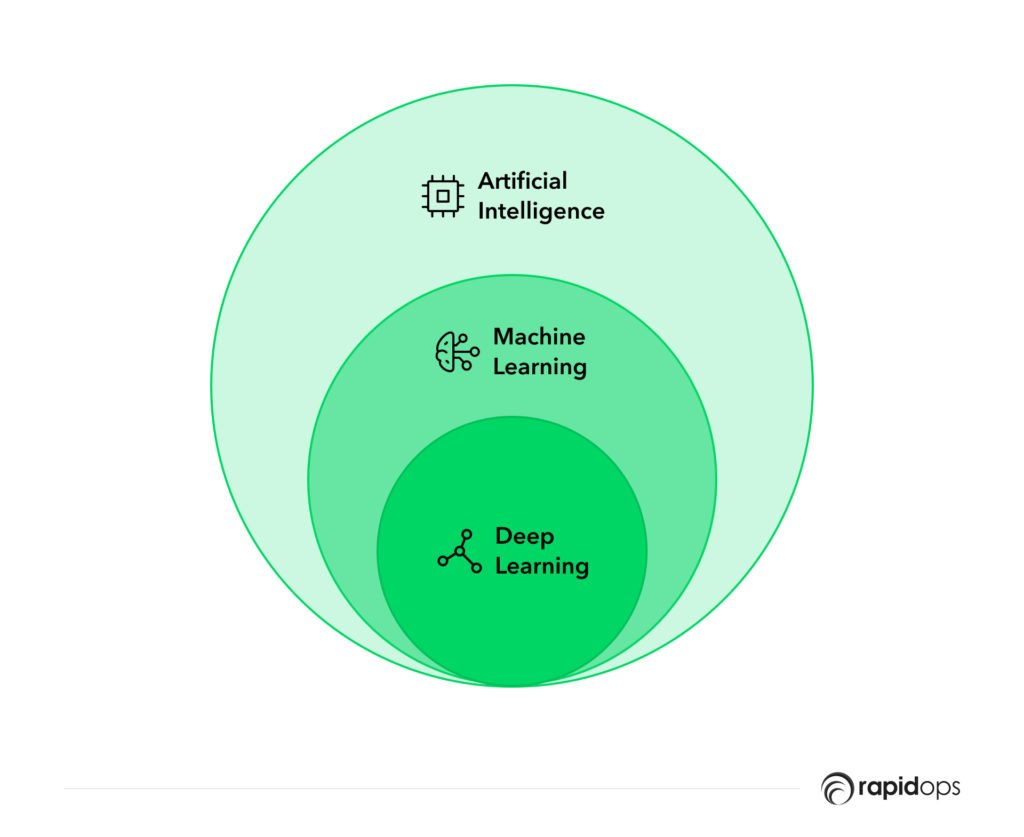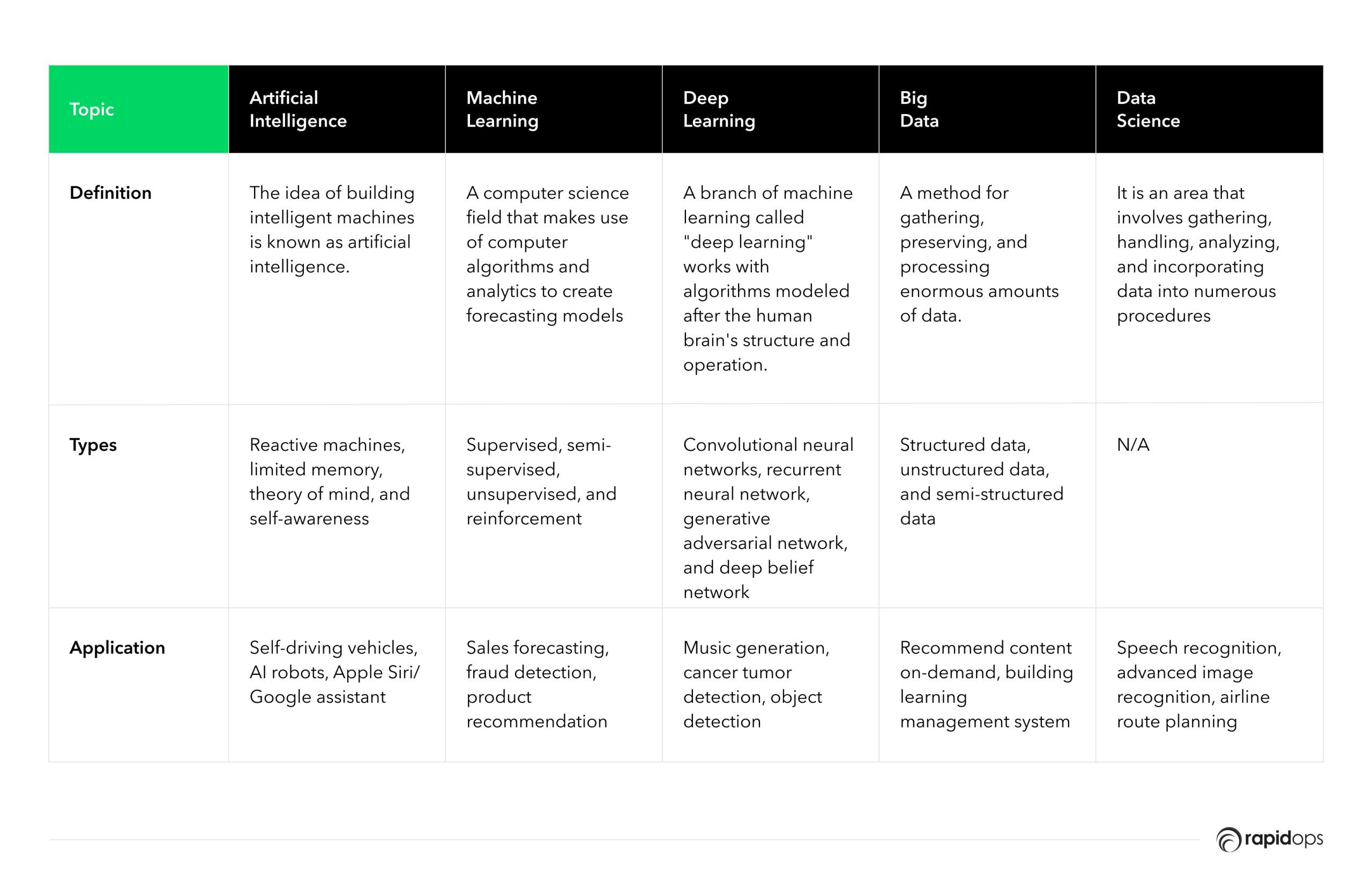We hear numerous buzzwords and AI terminologies every day through various sources. Some words do make sense, and some sound too foreign.
But assuming they are still far in the future to be in the application and utilization is not quite proper. Many a time, we don't even realize, but we are using Web 3.0 technologies and AI in the forms of voice assistants and other services.
So, dive deep if you want, or remain on the surface by going through the bullet points that will give you enough clarity and information on what jazz is all about!
Artificial Intelligence
The idea of building intelligent machines is known as artificial intelligence.
A subset of artificial intelligence called machine learning facilitates the development of AI-driven applications.
Deep learning is a kind of machine learning that trains models using enormous amounts of data and complicated methods.
Types of AI
Here are the types of AI that are popular and widely used for developing futuristic apps:
Reactive Machines: Machines that solely react. These systems don't keep track of past events or use them to inform current judgments.
Limited Memory: These systems use historical data, adding information over time. The details mentioned disappear quickly because when an ML model is created, it requires very limited memory to function properly.
Theory of mind: Systematic approaches to understanding human emotions and how they influence decision-making fall under the heading of the theory of mind. They are taught to modify the behavior as necessary.
Self-awareness: These systems were developed to be conscious of themselves. They are aware of their own internal states, can anticipate others' emotions, and behave appropriately.
Applications of artificial intelligence
- Machine Translation such as Google Translate
- Self-Driving Vehicles such as Google's Waymo
- AI Robots such as Sophia and Aibo
- Speech Recognition applications like Apple's Siri or OK Google
Want to keep up with the latest
AI advancements? Check out our up-to-date AI Tracker.
Explore NowMachine Learning

Machine learning is a computer science field that makes use of computer algorithms and analytics to create forecasting models that can resolve business issues.
It analyses enormous volumes of data (both structured and unstructured) to forecast the future. It uses various algorithms and methodologies to learn from the data.
The diagram that follows demonstrates how a computer learns from data:
Machine learning applications
- Sales forecasting for different products
- Fraud analysis in banking
- Product recommendations
- Stock price prediction
Deep Learning
A branch of machine learning called "deep learning" works with algorithms modeled after the human brain's structure and operation.
Large amounts of both structured and unstructured data can be used by deep learning systems. Artificial neural networks enable machines to make judgments and are the foundation of deep learning.
Types of deep learning
Convolutional neural networks (CNN): A class of deep neural networks that are most frequently utilized for image analysis.
Recurrent Neural Network (RNN): RNN creates models using sequential data. It frequently performs better for models that must retain historical data.
Generative Adversarial Network (GAN): It is an algorithmic architecture that produces fresh, artificial data instances that can be mistaken for actual data using two neural networks. A GAN trained on images can create new images that, to human viewers, at least appear legitimate.
Deep Belief Network (DBN): A generative graphical model which is made up of several layers of latent variables known as hidden units. The units are not connected, but each of its layers is.
Deep learning applications
- Cancer tumor detection
- Captionbot for captioning an image
- Music Generation
- Image Coloring
- Object detection
Relationship among AI, ML, and DL

Artificial intelligence has the ability to imitate human behavior. Meanwhile, Machine learning applies AI to learn and adapt from experiences, which eventually helps in creating AI-driven applications. Deep learning applies machine learning to train a model that can deal with vast volumes of data.
Machine learning is the subset of AI and uses statistical models, while deep learning uses that to train their models that eventually will lead to solving problems like tumor detection, diagnosis, medical research, etc.
The main distinction between deep learning and machine learning is how data is delivered to the machine.
Deep learning networks use numerous layers of artificial neural networks, whereas machine learning techniques often need structured data.
Big Data
Big data is a method for gathering, preserving, and processing enormous amounts of data. It explains how the data are related.
It is the pinnacle of data mining.
Big data involves sifting through a vast amount of data to find the most important and relevant information. It is a method for tracking and identifying trends in large, complex data sets.
It removes crucial information from the massive amount of data inside the pre-existing standard features, making data more essential and useable.
As enormous processing amounts of data are challenging, it is only automated.
Big data concentrates on and utilizes all types of data, whether they are organized, unstructured, or semi-structured.
It is mainly employed for commercial objectives and client satisfaction. A mine is big data.
Data Science
Data Science is an area that involves gathering, handling, analyzing, and incorporating data into numerous procedures. It is more abstract.
It helps in Building data-dominant products, which is the aim of a business. All data kinds, whether structured, unstructured, or semi-structured, are covered.
As data science includes data scraping, cleaning, visualization, statistics, and many other techniques, it is a superset of data mining. The majority of its uses are scientific.
Since it mainly focuses on data science, it bags the question, how data science and big data are different from one another?

Critical differences between data science and big data
- Organizations employ big data to increase productivity, comprehend undiscovered markets, and boost competitiveness.
Whereas data science is focused on offering modeling techniques and methodologies to precisely assess big data's possibilities.
- Big data refers to the enormous volumes of data that businesses can collect, but data science is required to use the data to extract useful information.
- The three Vs of big data—velocity, variety, and volume—define the dataset, but data science offers methods for data analysis.
- Data science focuses more on making decisions, whereas big data is more associated with technology, software, and computer tools.
Hence, Data science combines theoretical and practical methods to extract knowledge from big data, which is crucial for maximizing the value of big data. However, big data can be seen as a collection of facts that lacks credibility unless it is examined using deductive and inductive reasoning.
Difference between AI, ML, Deep Learning, Data Science, and Big Data

Final Words
Be it chatbots or Smart POS software, digital transformation in AI, ML, and everything else is happening everywhere.
Research suggests that because of the acceleration and adaptation of AI, the GDP will get a boost by up to 14%, which is a massive leap considering how economies have suffered during COVID'19.
So, check where your business stands, see where you can transform it to be future-ready, and implement the solutions while they are still inexpensive and popular to monopolize and monetize more!

Niyati Madhvani
A flamboyant, hazel-eyed lady, Niyati loves learning new dynamics around marketing and sales. She specializes in building relationships with people through her conversational and writing skills. When she is not thinking about the next content campaign, you'll find her traveling and dwelling in books of any genre!

Let’s build the next big thing!
Share your ideas and vision with us to explore your digital opportunities
Similar Stories
- AI
- 4 Mins
- September 2022

- AI
- 9 Mins
- January 2023


Receive articles like this in your mailbox
Sign up to get weekly insights & inspiration in your inbox.

